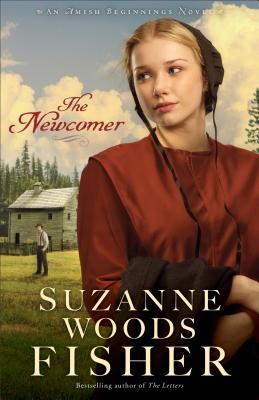5-Star Review of "The Newcomer"


Review of The Newcomer
Amish Begginings, Book #2
by Suzanne Woods Fisher
In 1737, Anna Konig and her fellow church members stagger off a small wooden ship after ten weeks at sea, eager to start a new life in the vibrant but raw Pennsylvania frontier. On the docks of Port Philadelphia waits bishop Jacob Bauer, founder of the settlement and father to ship carpenter Bairn. It's a time of new beginnings for the reunited Bauer family, and for Anna and Bairn's shipboard romance to blossom.
But this perfect moment cannot last. As Bairn grasps the reality of what it means to be Amish in the New World--isolated, rigid with expectations, under the thumb of his domineering father--his enthusiasm evaporates. When a sea captain offers the chance to cross the ocean one more time, Bairn grabs it. Just one more crossing, he promises Anna. But will she wait for him?When Henrik Newman joins the church just as it makes its way to the frontier, Anna is torn. He seems to be everything Bairn is not--bold, devoted, and delighted to vie for her heart. And the most dramatic difference? He is here; Bairn is not.
Far from the frontier, an unexpected turn of events weaves together the lives of Bairn, Anna, and Henrik. When a secret is revealed, which true love will emerge?
About the Author:

Suzanne Woods Fisher has a specialty: she writes about real people living in faith-based communities. With over 750,000 copies of books sold worldwide, she is the bestselling, award-winning author of more than twenty-five books, ranging from children's books ('The Adventures of Lily Lapp' series) to novels ("The Choice") to non-fiction books ("Amish Peace: Simple Living for a Complicated World").
When Suzanne isn't writing, she's probably playing with puppies. She's been involved with Guide Dogs for the Blind for over fifteen years. Raising puppies, she says, is like eating a potato chip. You just can't stop at one.
Readers are invited to stop by Suzanne's website at: www.suzannewoodsfisher.com
When Suzanne isn't writing, she's probably playing with puppies. She's been involved with Guide Dogs for the Blind for over fifteen years. Raising puppies, she says, is like eating a potato chip. You just can't stop at one.
Readers are invited to stop by Suzanne's website at: www.suzannewoodsfisher.com
Giveaway
To celebrate her tour, Suzanne is giving away a Kindle! Click below to enter.
Be sure to comment on this post before you enter to claim 9 extra entries!
Guest Post from Suzanne Woods Fisher
Pennsylvania of 1737, the setting for The Newcomer, is like a foreign country. Parts of it might seem familiar—the same hills and creeks and blue sky, but we’d hardly recognize the settlers. People like Anna, or Bairn, or the mysterious Newcomer. We wouldn’t be able to understand their language, their customs and traditions. Their world was that different from our modern one.
The first group of Amish immigrants (first written about in Anna’s Crossing and followed up in The Newcomer) settled northwest of Philadelphia, then a vast wilderness, and relied on each other for safety, security, building projects, and church. In nearby Germantown, settlers were tradesmen, so they clustered houses together in small knots. The Amish farmers took out land warrants for sizeable properties and lived considerable distances from each other.
In The Newcomer, Anna cooked food in a cauldron over a large hearth. One-pot meals can trace their beginnings to open-hearth cooking when ingredients for a meal went into a large kettle suspended over the fire. Traditional dishes—ham and beans, pork and sauerkraut—used sturdy, available, and simple ingredients that improved with long, slow cooking. The dishes could be easily expanded when the need arose to set a few more places at the table. And it did, often. Large families and unannounced company inspired Amish cooks to find ways to “stretch the stew.”
Noodles (including dumplings and rivvels) could be tossed into a simmering broth to make a meal stretch. Most farms had a flock of chickens, so eggs were easily at hand. Today, homemade noodles are still a favorite dish.
Another “stew stretcher” was cornmeal mush, originally eaten as a bread substitute. Early German settlers who made their home in eastern Pennsylvania roasted the yellow field corn in a bake oven before it was shelled and ground at the mill. The roasting process gave a nutty rich flavor to the cornmeal. Mush is still part of the diet the Old Order Amish—cooked and fried, baked, added into scrapple, smothered in ketchup. Dress it up and you’ve got polenta.
Now here’s one thing we do have in common with 1737 Pennsylvania immigrants…a love of good food and a shortage of time! Here’s one of my favorite one-pot recipes—probably not the kind of stew Anna might have made for ship carpenter Bairn or the mysterious Newcomer (ah, which man one stole her heart?)…but definitely delicious. Enjoy!
Lentil Chili
Here’s one of my favorite “stew stretchers.” You can expand it even more by serving over rice.
Ingredients:
1 onion, diced
1 clove garlic, minced
10 c. water
1 lb. dry lentils
1 tsp. cumin
1 tsp. chili powder
1 tsp. salt (season to your taste)
½ tsp. pepper 2 c. salsa (your favorite variety)
29 oz. canned tomatoes, crushed



Comments
Post a Comment
thanks for commenting! I love to hear from my friends and followers! Comments will be posted after approval due to the many spammers :(